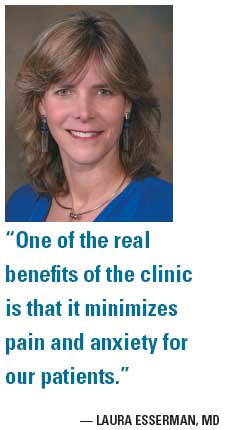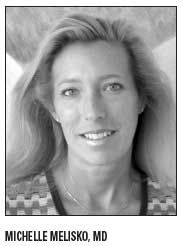New breast cancer program reduces time to treatment
In 1993, Laura Esserman, MD, took a trip to the UK and noted that breast cancer diagnosis was handled far diff erently than in the U.S. Because all the breast cancer imaging is done centrally in the UK, physicians offer same-day clinics.
ABSTRACT: New protocol at University of San Francisco delivers patients to oncology in days rather than weeks. The Coordinated Diagnostic Evaluation Program also decreases patient anxiety.
In 1993, Laura Esserman, MD, took a trip to the UK and noted that breast cancer diagnosis was handled far differently than in the U.S. Because all the breast cancer imaging is done centrally in the UK, physicians offer same-day clinics.

In one day, a woman with an abnormal mammogram can obtain further imaging, confer with a breast cancer specialist, and undergo biopsy if necessary. Dr. Esserman, director of the Carol Franc Buck Breast Care Center at the University of California, San Francisco, was inspired to provide the same back home.
“When we did focus groups (at UCSF), we found out that what women want is speed of diagnosis,” said Dr. Esserman, who is also a professor of surgery and radiology. “Ideally, we should be compressing the diagnostic time as much as possible and then giving women several weeks to learn about the disease, figure out their options, and decide on the best possible treatments.”
A year and a half ago, Dr. Esserman helped establish the Coordinated Diagnostic Evaluation Program (CDEP) at UCSF. CDEP compresses the time from initial mammogram to biopsy to diagnosis and treatment options from 42 days to nine days. If a patient is at high risk for breast cancer because of family history, same-day genetic counseling is also available.
CDEP has proved very popular with Dr. Esserman’s oncology colleagues. “There are real benefits to patients in going to the CDEP clinic in terms of decreasing anxiety. But medical oncologists also get the chance to see patients earlier in the process. And that’s really important for patients who have large tumors and may need neoadjuvant chemotherapy. We get a heads-up early on about patients who may

need this kind of treatment,” said Michelle Melisko, MD, an assistant clinical professor in hematology/oncology.

“Because CDEP is a comprehensive program that involves surgeons, radiation oncologists, and medical oncologists, patients get very well educated when they come through the clinic,” commented Hope Rugo, MD, clinical professor of medicine.
“By the time patients get to the medical oncologist, they’re more educated than the average patient about their options. That makes the job of the medical oncologist easier in providing the best treatment possible,” Dr. Rugo said.
Dr. Esserman, along with Suzanne Eder, NP, discussed the CDEP experience experience at the 2008 Breast Imaging and Cancer: Multidisciplinary Approach to Breast Cancer Symposium, hosted by UCSF.
Decreasing patient anxiety, streamlining patient care The anxiety that women have about the breast cancer screening process has been well documented. A recent Canadian study of 631 subjects undergoing screening found that 51% described themselves as quite or very anxious at every stage of the prediagnostic phase (Oncol Nurs Forum 34:847-853, 2007).
“Shortening the time between initial screening and diagnosis can dramatically minimize patient anxiety,” Dr. Esserman said.
Seventy percent of patients who arrive at the CDEP clinic receive their diagnosis and follow-up about their treatment options within a day or two after screening or diagnostic studies. Some biopsies can’t be accomplished on the same day, such as surgical and MRIguided biopsies. “These procedures are too complicated to assemble the expertise needed in one day,” she said.
A breast surgeon and a radiologist on the CDEP team review all the imaging done at the clinic and make recommendations on the day the patient visits. Consultations with oncologists are often held within the nine-day turnaround time.
“If neoadjuvant chemotherapy is a consideration, we can often have the patient at least meet the medical oncologist the same day and then schedule a formal appointment in the next week,” Ms. Eder explained. “Radiation is usually done after surgery, so we don’t make that referral until after surgery.”
“It’s a very collaborative approach, and that benefits the patient’s treatment. It also means that even if there is nothing found on biopsy, patients develop a level of comfort with the healthcare team at the CDEP clinic. So if they have to come in for a biopsy down the line, they’re not terrified,” Dr. Rugo said.
Streamlining coordination between the breast cancer clinic and radiology departments also makes it possible to improve analysis of imaging tests, and patients and oncologists can avoid unnecessary procedures. Dr. Esserman has found that 25% of the patients coming through the CDEP clinic who were initially recommended for biopsy by outside clinics or health plans could avoid these procedures in favor of watchful waiting after analysis by the CDEP team.
Since the clinic began almost two years ago, there have been some changes as the staff has become more efficient and learned the best ways of dealing with patients. “When I first started in the same-day clinic, I wanted to make sure that everyone got a diagnosis the same day. But what I eventually figured out is that some people aren’t ready. They need a day to go home, prepare, and perhaps bring a relative or friend back. Then they can hear the diagnosis in the next day or two,” Dr. Esserman said.
She also noted that some functions of the clinic have become automated; for instance, an online health evaluation form is available for patients to fill out before they come in to the clinic.
Looking ahead Could such a same-day clinic be used at other cancer centers? Dr. Esserman and Ms. Eder, who helps coordinate the CDEP clinic, said that they believe that it could be. Since a same-day diagnosis clinic requires a lot of organization among different services in a medical center, it helps if the hospital has already built a structure for such coordination with a multidisciplinary breast cancer clinic, Ms. Eder said. Geography also matters. At UCSF, the radiology department is just across the hall from the breast care clinic, so patients don’t have to be shuttled from one end of the hospital to another for services.
Although it’s clear that the CDEP clinic has benefits for both patients and oncologists-in streamlining the time to diagnosis and improving imaging analysis-the staff is planning more features for the future. They eventually hope to integrate imaging and pathology reports and make them available online to both providers and patients.
They’re also working on a personalized risk module that incorporates the Gail risk score as well as other risk factors for breast cancer, which they eventually hope to make available to physicians and patients online. Routine counseling about prevention should be a basic component of screening, and these online tools would help facilitate this. Certainly, the CDEP clinic’s accomplishments haven’t come without a price. “Th e clinic does take a lot of coordination, and it’s quite labor-intensive, but it does streamline care,” Ms. Eder said.
But for the CDEP team, the price has been worth it. “One of the real benefits of the clinic is that it minimizes pain and anxiety for our patients,” Dr. Esserman said.
Breast imaging: What’s next?
UCSF’s Nola Hylton, PhD, and Chris Flowers, MD, highlighted what’s on the horizon for advanced breast imaging:
Tomosynthesis. A 3D x-ray technique that reduces image superimposition and picks up lesions that may be missed on standard mammography, tomo has demonstrated high accuracy rates in dense breast tissue. Breast tomo would require investment in new equipment. “It has great potential, but it’s not fully evaluated yet and there are technical issues. There could also be cost problems,” Dr. Hylton said.
Dual-energy mammography. Th e technology provides two different images-one high energy and one low energy-using temporal subtraction to subtract mask from contrast images. It could help radiologists see through dense tissue and improve image clarity. “The downside of this technology is that it requires giving people contrast agent. But it could be done with existing mammography machines,” Dr. Flowers said.
Contrast-enhanced ultrasound. A technique that’s currently being used in Europe, it improves on ultrasound’s ability to image areas of abnormal blood flow and to catch small tumors. Again, a downside is the use of contrast agents.
Computer-aided detection (CAD). Paired with screening mammography, CAD has shown significant utility in finding clustered microcalcifications and spiculated lesions. CAD has demonstrated moderate utility for poorly defined masses and asymmetry. A recent study in Th e New England Journal of Medicine found that when single reading is standard practice, CAD had the ability to detect as many cancers as those found by double reading (N Engl J Med 359:1675- 1684b, 2008).
Newsletter
Stay up to date on recent advances in the multidisciplinary approach to cancer.